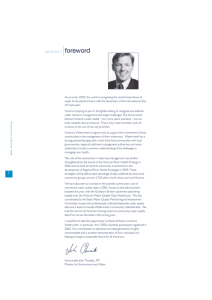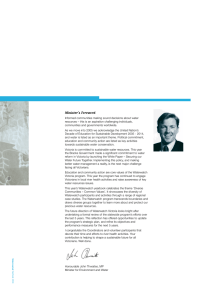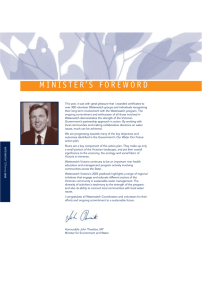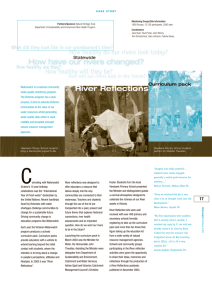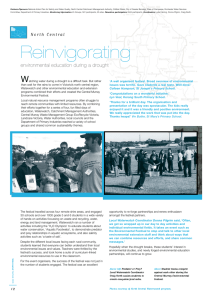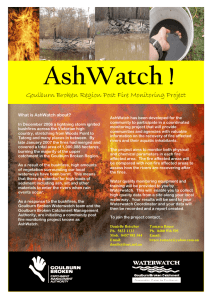Statewide Summary Celebrating success in 2006/07
advertisement
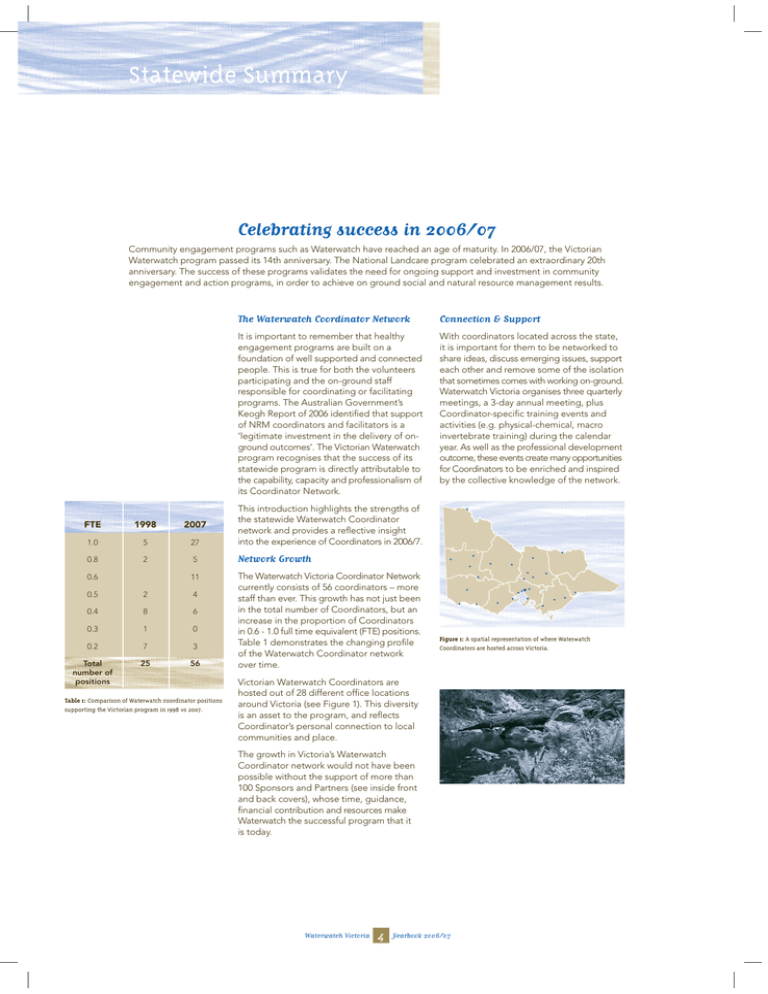
Statewide Summary Celebrating success in 2006/07 Community engagement programs such as Waterwatch have reached an age of maturity. In 2006/07, the Victorian Waterwatch program passed its 14th anniversary. The National Landcare program celebrated an extraordinary 20th anniversary. The success of these programs validates the need for ongoing support and investment in community engagement and action programs, in order to achieve on ground social and natural resource management results. The Waterwatch Coordinator Network Connection & Support It is important to remember that healthy engagement programs are built on a foundation of well supported and connected people. This is true for both the volunteers participating and the on-ground staff responsible for coordinating or facilitating programs. The Australian Government’s Keogh Report of 2006 identified that support of NRM coordinators and facilitators is a ‘legitimate investment in the delivery of onground outcomes’. The Victorian Waterwatch program recognises that the success of its statewide program is directly attributable to the capability, capacity and professionalism of its Coordinator Network. With coordinators located across the state, it is important for them to be networked to share ideas, discuss emerging issues, support each other and remove some of the isolation that sometimes comes with working on-ground. Waterwatch Victoria organises three quarterly meetings, a 3-day annual meeting, plus Coordinator-specific training events and activities (e.g. physical-chemical, macro invertebrate training) during the calendar year. As well as the professional development outcome, these events create many opportunities for Coordinators to be enriched and inspired by the collective knowledge of the network. FTE 1998 2007 1.0 5 27 This introduction highlights the strengths of the statewide Waterwatch Coordinator network and provides a reflective insight into the experience of Coordinators in 2006/7. 0.8 2 5 Network Growth 0.6 11 0.5 2 4 0.4 8 6 0.3 1 0 0.2 7 3 25 56 The Waterwatch Victoria Coordinator Network currently consists of 56 coordinators – more staff than ever. This growth has not just been in the total number of Coordinators, but an increase in the proportion of Coordinators in 0.6 - 1.0 full time equivalent (FTE) positions. Table 1 demonstrates the changing profile of the Waterwatch Coordinator network over time. Total number of positions Table 1: Comparison of Waterwatch coordinator positions supporting the Victorian program in 1998 vs 2007. Figure 1: A spatial representation of where Waterwatch Coordinators are hosted across Victoria. Victorian Waterwatch Coordinators are hosted out of 28 different office locations around Victoria (see Figure 1). This diversity is an asset to the program, and reflects Coordinator’s personal connection to local communities and place. The growth in Victoria’s Waterwatch Coordinator network would not have been possible without the support of more than 100 Sponsors and Partners (see inside front and back covers), whose time, guidance, financial contribution and resources make Waterwatch the successful program that it is today. Waterwatch Victoria Yearbook 2006/07 Coordinators connected to place and people In a reflective activity held at the statewide Waterwatch Coordinators Meeting in Hepburn Springs, December 2006, Waterwatch Coordinators were asked to journal their experiences over the previous 12 months. Personal connection to place and people consistently featured as an important and meaningful part of the role. The following excerpts provide an insight into Coordinator’s lives and highlights. Drying of the Wimmera River needs to be seen as an opportunity to learn something in the environment that we couldn’t do otherwise: i.e. visit the river bed, look at plants, footprints, creatures and landform from the bed’s perspective, dig holes in the spirit of Australian desert explorers to see if there is water underground and if it’s too salty to save us!’ ‘The thing I like most about my job is that I am responsible for what I deliver to the community and how. I have the freedom to be creative and try different things, and I’m always learning more about what works and what doesn’t.’ ‘This year’s drought and water shortages have become front page news, and friends and family and complete strangers are talking about water, wanting to know more. Their questions of course are coming from a water consumption viewpoint, so it is challenging to keep up with what is happening in water allocation, the pros and cons for alternate sources (e.g. Recycled water) and how this affects river health, so that I can contribute new angles to those informal conversations (other than those portrayed in the media).’ ‘The two volunteer groups I am most excited about are a post-bushfire group that have been operating for almost 12 months now and a group combining photo point monitoring with water quality as part of the EWR program on the Thomson River.’ My West Gippsland highlights included an evening whereby many of the older and sometimes retired Waterwatch community gathered at the Gippsland Grammar Chapel in Sale to recognize 10 years, 10 years of wetlands, 10 years of school visits, 10 years of still being here. It was a tremendous night with monitors doing their own presentations. ‘I am looking forward to the State conference where I can tap into the fantastic minds of you other Waterwatch Coordinators and receive yet another dose of inspiration for the task ahead as well as catching up with new and ‘old’ coordinators.’ ‘I now work much closer with the community than before which I really enjoy and feel a real sense of being able to make a difference when I see how enthusiastic and passionate many of them are.’ ‘I have been overwhelmed with [the local community’s] enthusiasm, considering the harsh drought conditions many of these people face. Many creeks are dry at various sites, yet I haven’t met a person yet that has said this [monitoring] project seems futile [during the drought].’ ‘Events in 2006 such as Catch a carp, Frogs on (bicycle) wheels, catchment tours, National Water Week on the Darebin Creek, tree planting and cultural awareness events have been spectacular!’ ‘I have only been a part of the Vic Waterwatch network for 3 years, but I haven’t seen the program, as a whole, as strong as it is right now. Support seems to be increasing across the regions, success stories are plentiful, and numbers of staff are higher than they have ever been. Sweet.’ Yearbook Theme and Structure This year’s theme ‘Connection to Place’ provides a great platform to demonstrate the diverse ways that Waterwatch connects local communities to their own local environment and issues. It is also a great opportunity to shine the light on volunteers, partners and supporters whose individual actions are at the heart of the Waterwatch program. You may also notice that this year’s Yearbook is a bigger edition, providing case study examples of how and where regional Waterwatch programs achieve the five statewide program objectives. This is a move toward better reporting on the outcomes of the Waterwatch Program in Victoria, and we hope this new format provides a richer illustration of what is being achieved through the program in community awareness, education and participation in water management and river health. The Victorian Waterwatch objectives are: Definition of Yearbook statistics 1.Increase community awareness, understanding and ownership of water issues and their relationship to catchment health. •Number of monitoring groups (Standard 3 or 4* groups, actively monitoring) 2.Involve communities monitoring their local waterways to collect and provide data which is credible, accepted and used. 3.Increase community involvement in water management decisions and gain community commitment to action in addressing waterway and catchment issues. 4.Establish and maintain effective partnerships between the community and catchment managers. 5.Provide school learning opportunities and be an integral part of the curriculum. •Number of monitoring participants (Standard 3 or 4* participants, actively monitoring) •Number of sites (actively monitored by above groups/monitors a minimum of 4 times/year) •Number of education participants (involved in Waterwatch education and awareness raising activities) •Coordinator FTEs (fulltime equivalent staffing of program) •Program budget (financial program investment, in-kind support not included) *Minimum criteria for Standard 3 and 4 monitoring is defined in Waterwatch Victoria’s Data Confidence Framework and Guidelines. Standard 3 and 4 Waterwatch groups/participants monitor water quality for the purpose of collecting scientific, credible data. Regional Data Confidence Plans contain specific information on how Standard 3 and 4 monitors are supported to achieve this aim. Waterwatch Victoria Yearbook 2006/7
